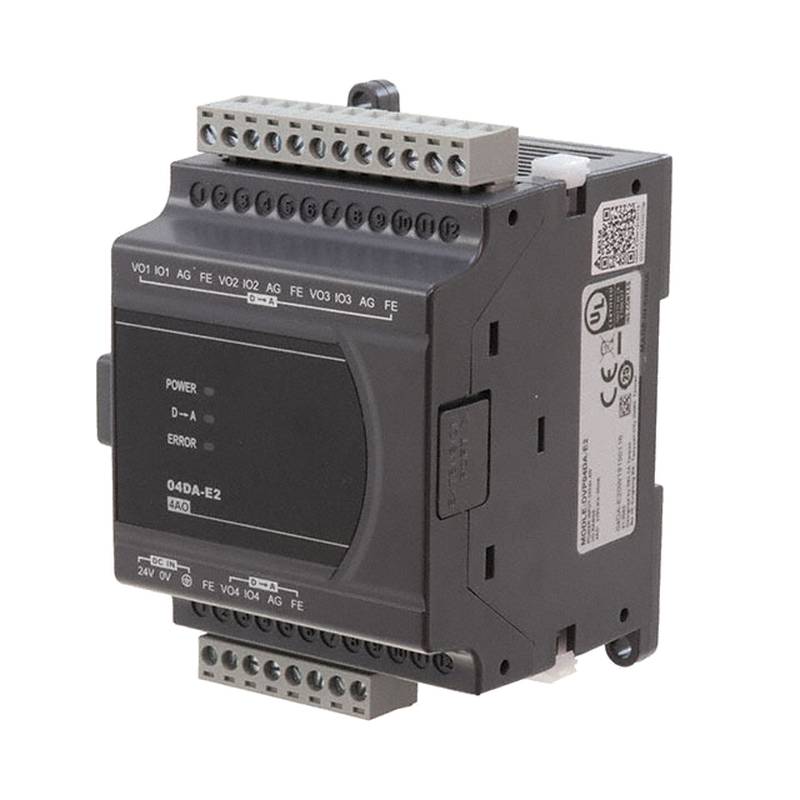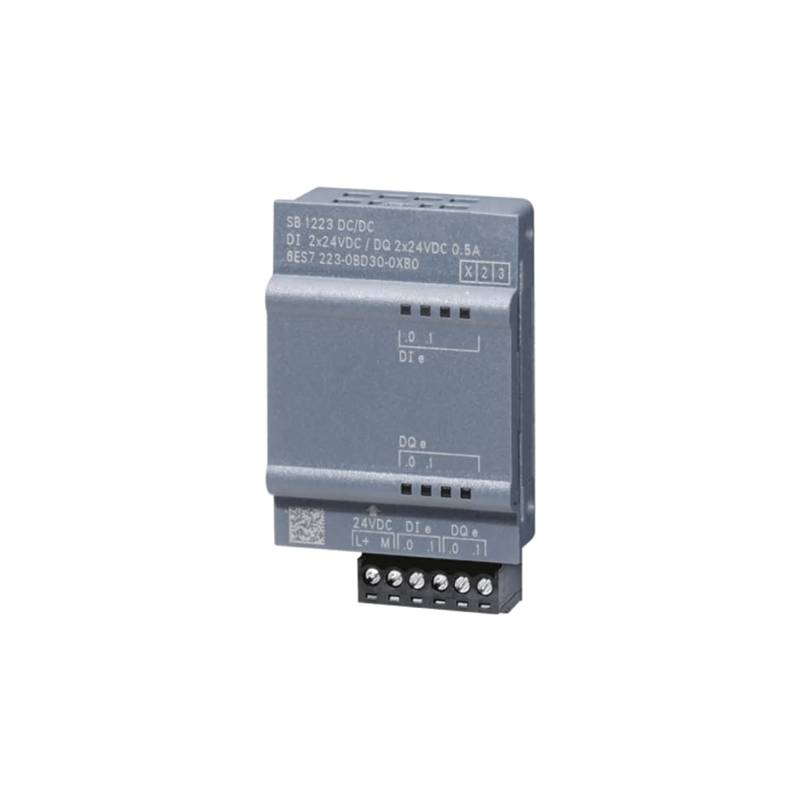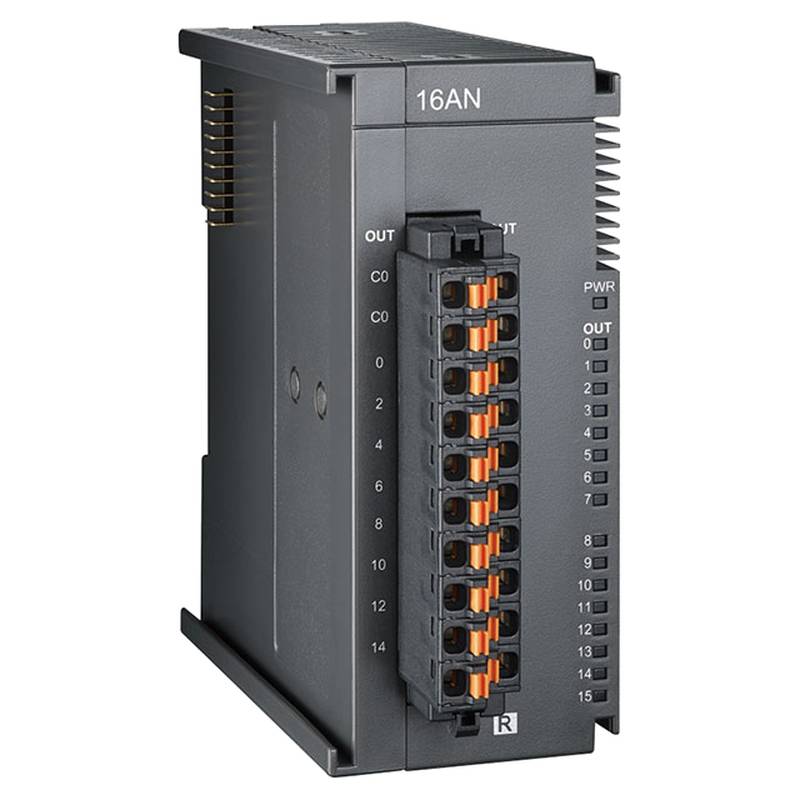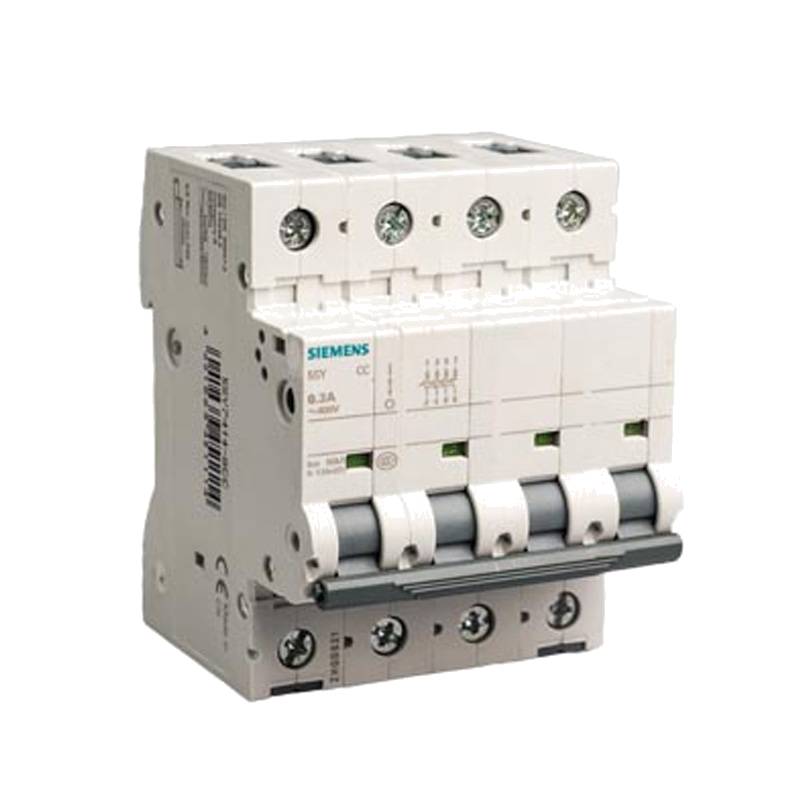
The Delta DVP04DA-E2 stands as a robust 4-channel analog output expansion module within the highly regarded DVP series, engineered to empower industrial automation systems with precise control over analog signals. This module is meticulously designed to seamlessly integrate with Delta's DVP Programmable Logic Controllers (PLCs), offering enhanced functionality for a myriad of demanding applications. Its core advantages lie in its high precision, reliability, and straightforward integration, making it a preferred choice for engineers seeking to optimize analog signal output within their control architectures. The DVP04DA-E2 boasts a resolution of 12-bit, ensuring fine-grained control over output signals, and supports a wide output range of ±10V, 0-5V, 0-10V, and 4-20mA, providing exceptional flexibility for diverse instrumentation needs.
Product Specifications
| Feature | Specification |
| :-------------------- | :------------------------------------------------ |
| Model | DVP04DA-E2 |
| Series | DVP Series |
| Output Channels | 4 analog output channels |
| Output Type | Voltage (±10V, 0-5V, 0-10V), Current (4-20mA) |
| Resolution | 12-bit |
| Output Accuracy | ±1% of full scale |
| Response Time | Typically 1ms |
| Isolation | Not isolated between channels |
| Power Consumption | 5VDC @ 80mA, 24VDC @ 10mA |
| Operating Temperature | 0°C to 50°C (32°F to 122°F) |
| Dimensions (W x H x D)| 86mm x 90mm x 60mm |
| Mounting | DIN rail or screw mounting |
Core Features & Market Positioning
The Delta DVP04DA-E2 distinguishes itself in the competitive industrial automation landscape through its exceptional channel density and versatile output options. Its ability to provide four independent analog outputs from a single module significantly reduces cabinet space and wiring complexity compared to using multiple single-channel modules. The module's high 12-bit resolution translates into superior control accuracy, which is critical for applications requiring precise manipulation of variables like motor speed, valve position, or heating elements. Market positioning favors the DVP04DA-E2 as a cost-effective yet high-performance solution for small to medium-sized automation projects where reliable analog output expansion is paramount. Its compatibility with the widely adopted DVP PLC platform further solidifies its appeal, offering seamless integration and leveraging existing user expertise.
Key Application Scenarios
Engineers frequently integrate the Delta DVP04DA-E2 into systems requiring precise analog signal generation. Common scenarios include the precise control of Variable Frequency Drives (VFDs) for motor speed regulation, allowing for smooth acceleration and deceleration profiles essential in manufacturing and material handling. Another critical application is the proportional control of pneumatic or hydraulic valves, enabling fine-tuned flow rate adjustments in process industries such as chemical processing, water treatment, and food and beverage production. Furthermore, the module is instrumental in driving actuators, controlling temperature regulation systems through precise heating element outputs, and providing feedback signals for sophisticated process monitoring and data acquisition. Its versatility makes it a go-to component for applications demanding accurate and reliable analog signal manipulation.
Practical System Integration Guidance
Integrating the Delta DVP04DA-E2 into a DVP PLC system is a streamlined process. The module connects directly to the PLC's expansion bus, typically via a ribbon cable, ensuring a robust electrical connection. Wiring for analog outputs involves connecting the common terminal to the appropriate power source (e.g., 0V or 24VDC depending on the configuration) and then routing the individual output signals to the target devices, such as VFDs or control valves. For voltage outputs, ensure the external load impedance is sufficiently high to avoid signal degradation. For current outputs, a 250-ohm resistor is often used in series with the load to facilitate voltage measurement if needed. Programming within the DVP PLC environment involves using specific output instructions to write data values to the module's internal registers, which are then converted into the desired analog output signals based on the configured output range.
Operation and Risk Mitigation
Operating the Delta DVP04DA-E2 requires adherence to proper wiring and configuration practices to ensure optimal performance and prevent damage. Users must carefully select the appropriate output range (voltage or current) in the PLC programming software to match the requirements of the connected end devices. Overloading analog output channels or connecting them to incompatible voltage/current sources can lead to module failure. It is crucial to verify the power supply specifications for the PLC and the expansion module to ensure they are within the operational limits. Faulty wiring, such as reversed polarity on current loops or incorrect voltage connections, is a common cause of malfunction. Implementing proper grounding techniques for the system can help mitigate electrical noise interference, which might otherwise affect the accuracy of the analog signals.
Scalability & Long-Term Value
The Delta DVP04DA-E2 offers significant long-term value through its inherent scalability and compatibility within the broader Delta automation ecosystem. As systems evolve and demand more sophisticated control, additional DVP series expansion modules, including other analog or digital I/O modules, can be easily added to the existing DVP PLC base unit, provided the PLC's expansion capacity is not exceeded. This modular approach allows for incremental upgrades and expansions, ensuring the automation infrastructure can adapt to changing production needs without requiring a complete system overhaul. Furthermore, Delta's commitment to industrial automation means that modules like the DVP04DA-E2 are designed for longevity and integration with emerging technologies, including potential future advancements in IIoT connectivity and cloud-based data analytics, making it a sound investment for future-proofing industrial operations.
Frequently Asked Questions
What is the primary function of the Delta DVP04DA-E2?
The Delta DVP04DA-E2 serves as a crucial analog output expansion module for Delta's DVP series PLCs. It provides four independent channels that can output precise analog signals, typically voltage or current, to control external devices.
This module allows for fine-tuned manipulation of process variables, acting as a bridge between the digital control logic of the PLC and the analog world of actuators and sensors. Its high resolution ensures accurate signal generation, vital for demanding industrial applications where precision is key.
By adding this module, automation engineers can expand the analog output capabilities of their existing DVP PLC systems, enabling more sophisticated control strategies and the management of a wider range of equipment.
How do I configure the output ranges on the DVP04DA-E2?
Output range configuration for the DVP04DA-E2 is performed within the Delta WPLSoft programming software. Users select the desired output type (voltage or current) and the specific range (e.g., 0-10V, 4-20mA) for each of the four channels.
This software-based configuration is flexible and can be easily modified, allowing for adjustments during system commissioning or even during operation if required. The PLC's internal memory stores these settings, ensuring they are maintained even if power is lost.
It's imperative to match the configured output range precisely to the input requirements of the connected end device, such as a VFD or control valve, to guarantee correct operation and prevent potential damage.
What are the typical applications for the Delta DVP04DA-E2 module?
This module is widely employed in applications demanding precise analog control. Examples include variable speed motor control via VFDs, proportional valve positioning, temperature regulation systems, and precise control of servo actuators.
It is also integral to process automation where variables like flow rate, pressure, or level need to be accurately adjusted and maintained within specific parameters. The four independent channels offer significant flexibility for managing multiple control loops simultaneously.
Its high resolution and reliable output make it suitable for industries such as manufacturing, water treatment, chemical processing, and packaging, where consistent and accurate analog signal generation is critical for product quality and operational efficiency.
Can the Delta DVP04DA-E2 be used with PLCs from other manufacturers?
The Delta DVP04DA-E2 is specifically designed to be an expansion module for Delta's DVP series PLCs. It utilizes Delta's proprietary communication protocol and physical interface for seamless integration with DVP base units.
While it's technically possible to interface with non-Delta PLCs through custom hardware or complex communication gateway solutions, this is generally not recommended or cost-effective. The intended use and optimal performance are achieved when paired with a compatible Delta DVP PLC.
For applications requiring integration with third-party PLCs, it is advisable to explore alternative analog output modules designed for those specific PLC platforms or to consult with system integrators for potential custom solutions.
What is the meaning of "12-bit resolution" for the DVP04DA-E2?
A 12-bit resolution means the module can divide its analog output range into 4096 distinct levels (2^12 = 4096). This allows for very fine adjustments to the output signal, leading to more precise control over connected devices.
For example, in a 0-10V output range, each increment represents approximately 2.44mV (10V / 4096). This high level of granularity is crucial for applications requiring subtle changes in speed, position, or flow.
This precise signal generation capability distinguishes the DVP04DA-E2 from modules with lower resolutions, making it ideal for processes where even small deviations can impact product quality or operational efficiency.
How does the DVP04DA-E2 handle electrical noise interference?
While the DVP04DA-E2 itself does not have active noise filtering circuitry, proper system design and installation are key to mitigating electrical noise. This includes using shielded analog signal cables and ensuring they are routed away from high-power electrical lines.
Effective grounding is also critical. All equipment connected to the module and the PLC system should be properly grounded to a common grounding point. This helps to minimize voltage potential differences and provides a path for noise currents to dissipate safely.
The module's design benefits from the overall robust electrical engineering practices employed by Delta in the DVP series. However, users must implement best practices in wiring and installation to ensure signal integrity in electrically noisy industrial environments.
What are the power requirements for the Delta DVP04DA-E2?
The DVP04DA-E2 requires power from the connected DVP PLC's 5VDC bus, drawing approximately 80mA. Additionally, it requires a separate 24VDC power source for its analog output circuitry, consuming about 10mA.
It is essential to ensure that the DVP PLC's power supply has sufficient capacity to provide the 5VDC to the module without overloading. The 24VDC supply must also be stable and meet the module's specifications for reliable analog output generation.
Incorrect or unstable power supply can lead to erratic output signals, reduced accuracy, or complete module malfunction. Always refer to the official Delta documentation for precise power requirement specifications.
Is the Delta DVP04DA-E2 isolated between channels?
No, the Delta DVP04DA-E2 is not isolated between its four analog output channels. This means that all four output channels share a common ground or reference potential internally.
Consequently, it is crucial to ensure that the devices connected to these channels are compatible with this non-isolated configuration. Connecting devices that require separate ground references could lead to interference or damage.
For applications demanding complete electrical isolation between analog output channels, alternative modules with built-in isolation features would need to be considered. Always verify the isolation specifications for critical applications.
How do I wire the 4-20mA current output for the DVP04DA-E2?
To wire the 4-20mA current output, connect the module's common terminal to the negative side of your 24VDC power supply. Then, connect the positive side of the 24VDC supply to the input of your load (e.g., a transmitter or actuator).
Finally, connect the output terminal of your load to the corresponding analog output channel on the DVP04DA-E2. A 250-ohm resistor might be internally or externally required depending on the specific output configuration for proper current sensing or signal conversion.
Ensure the total loop resistance (including wiring and load) does not exceed the module's specified maximum limit to maintain accurate current output and prevent signal degradation.
What happens if I exceed the module's operating temperature range?
Operating the Delta DVP04DA-E2 outside its specified temperature range (0°C to 50°C or 32°F to 122°F) can lead to performance degradation and premature component failure. Extreme temperatures can affect the accuracy of the analog outputs.
Consistent operation at elevated temperatures can accelerate the aging process of electronic components, potentially reducing the module's lifespan and reliability. Conversely, operating in excessively cold conditions might initially impede proper function until the module reaches its operational temperature.
For optimal reliability and longevity, it is essential to install the DVP04DA-E2 in an environment that maintains ambient temperatures within the specified operational limits, considering factors like heat generated by other control panel components.
























